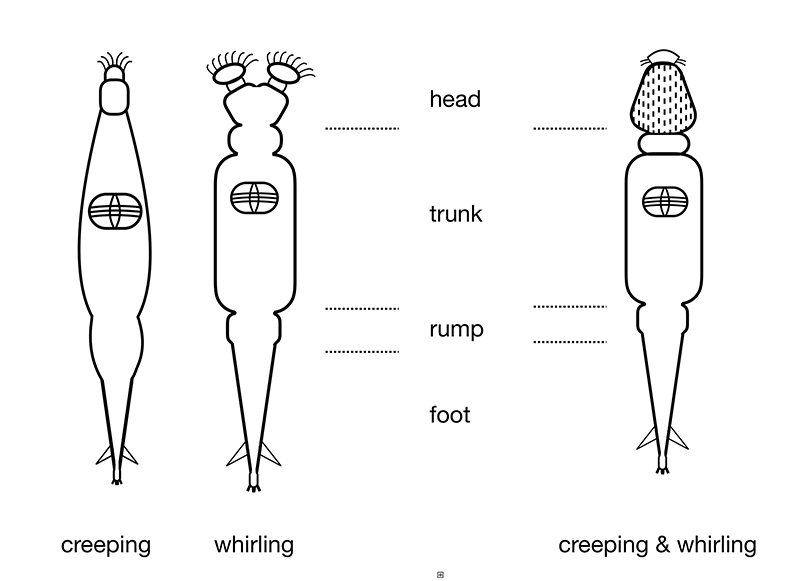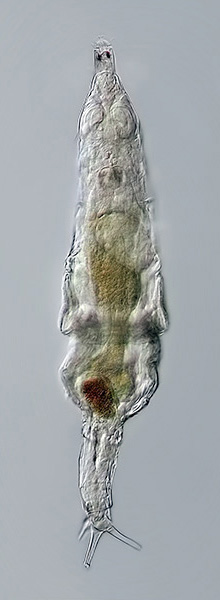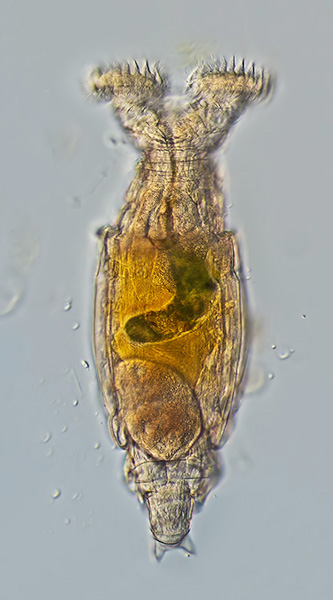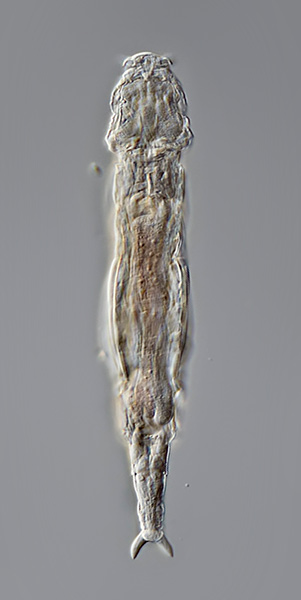| Identification of bdelloid rotifers is not easy. There are some very good keys for the identification, they are scientifically corect, but for the beginner it is difficultt to understand. |
| |
| basic morphology of bdelloids |
| Very simplyfied scheme of the morpholgy of bdelloid rotifers |
 |
   |
| Juxtaposition of a very simplyfied scheme of the morpholgy of bdelloid rotifers with some photographs of specimens from the corresponding groups. Basically the bdelloid rotifers have 4 body parts: head, trunk, rump and foot. The two images on the left side represent the two different types of appearance of the groups Philodinida and Philodinavida, whereas the right image represents the appearance of a rotifer of the group Adinetida. In the latter group the shape during locomotion or feeding is essentially the same. In the other group (left) the typical "bdelloid" (= leech-like) movement shows a different appearance of the frontal part (with the rostrum pointing forward and the corona retracted). For most Philodinida and Philodinavida it is impossible to securely identify a specimen in this creeping mode. |
| The basic body parts of a bdelloid rotifer are: head, trunk, rump, and foot with toes and spurs. |
| |
| |
| Details: the head |
| |
This schematic drawing shows the different types of reproduction of the Monogonont rotifers The left cycle (red): parthenogenesis by amictc egg; right: sexual reproduction (green/ blue) by males (blue) which results in a resting egg. |
| |
| |
| Details of anterior part |
| The Monogononta have different types of eggs. The eggs that are produced while reproducing parthenogenetically are diploid (red: 2n) and are either carried by the female, for example Anuraeopsis, Brachionus, deposited near the sheath (for example: Collotheca; Ptygura) or they develop inside the mother until the daughter is born (eg. Asplanchna; Rhinoglena). These eggs are called amictic eggs, becaues they develop without mixis (fertilization by a haploid sperm cell). Parthenogenetic reproduction enables the population to increase rapidly because there is no need for finding a sexual partner, which is always an advantage if the distance between specimen is large, eg in lakes or ponds. As a consequence the rotifer population can more effectively exploit food resources, for example planktonic algae which start growing with increasing day length / light in spring. |
| |
| The monogonont rotifer Polyarthra vulgaris carrying an amictic egg. |
| |
| Details of trunk |
| The other type of reproducing is sexually by mictic eggs. When a so-called "mictic stimulus" ("Mixis stimulus" in German) occurs in the environment, which could be for example changes in the chemical composition of the surrounding water or the temperature, the females may produce haploid eggs (green: 1n). If these eggs are not fertilized they develop into haploid males (blue) which are usually pretty much smaller (there are exceptions, for instance Asplanchna) and look different from the females (sexual dimorphism). The males can now fertilize the mictic eggs of mictic females (blue+green: 1n+1n). These fertilized eggs (brown) are called "resting eggs". The resting eggs have a mechanichally and also chemically very durable shell which is species-specific and enables the egg to survive bad environmental conditions like ice in ponds or dry seasons. |
| |
| |
| Details of foot |
| |
| |
| mating |
| |
| |
| |
| resting eggs |
| |
| |
|
|
|
| |
| |